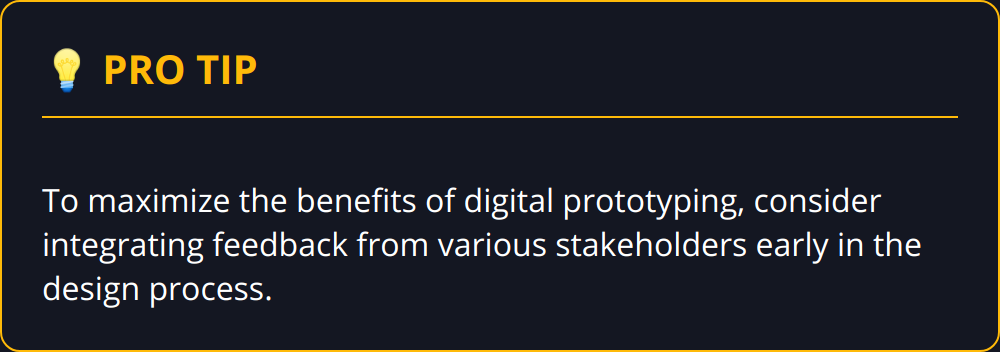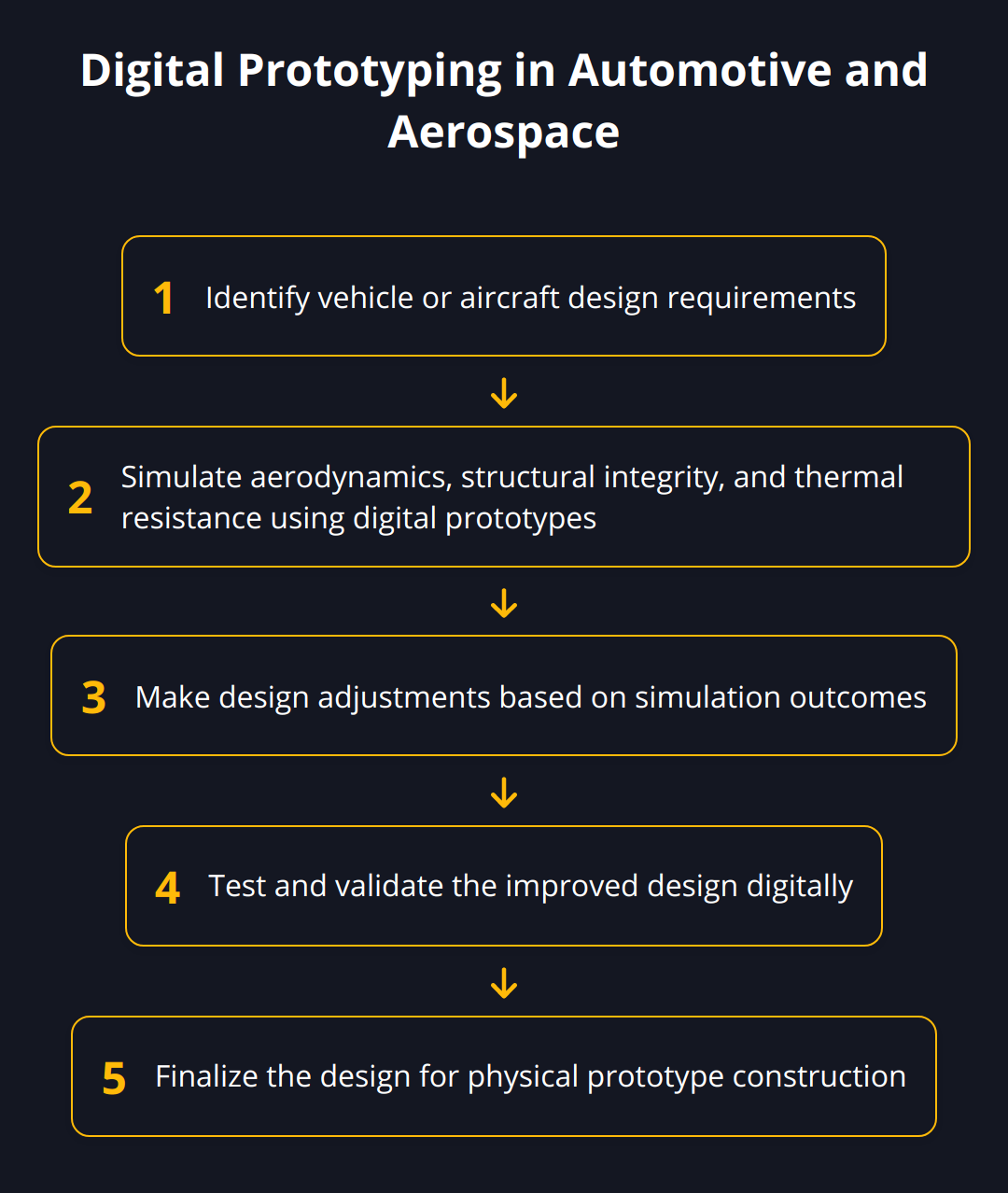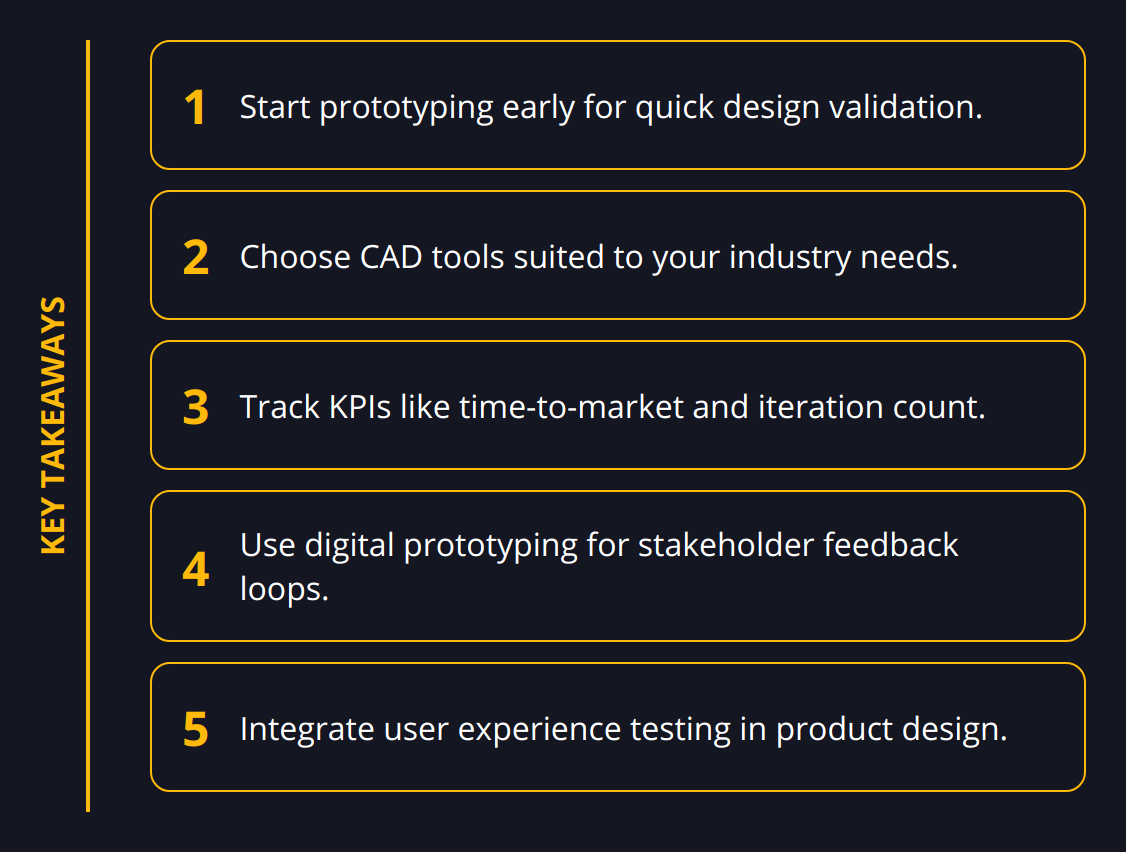We at Newroom Connect believe that the shift from traditional to digital methods in prototyping represents a significant transformation in the way industries operate. Digital prototyping streamlines product development, offering a wealth of benefits from reduced time and costs to enhanced collaboration.
In the evolving landscape of innovation, understanding these advantages is key for businesses looking to maintain competitive edges and foster growth. This post provides a detailed exploration of digital prototyping’s impact and practical guidance for integrating it into your business strategy.
Why Use Digital Prototyping?
The manufacturing and design landscapes have undergone a radical change, moving toward efficiency, speed, and precision. Digital prototyping has been at the forefront of this shift, redefining how we model, test, and modify products in a virtual environment before committing to costly physical production.
Digital prototyping is more than a buzzword; it’s a transformative approach enabling teams to create detailed simulations of products using computer-aided design (CAD) software. These virtual models can be rapidly iterated, allowing for immediate feedback and adjustments. Digital prototypes can incorporate various dimensions of a product, including its physical characteristics and the way it functions. This significantly shortens development cycles and reduces the need for multiple physical prototypes.

The journey from physical to digital prototypes represents a leap into greater agility and innovation. Traditional prototyping can be resource-intensive and time-consuming, often involving the creation of one-off models that offer limited insights until late in the design process. Digital prototyping, on the other hand, allows teams to validate concepts, test user interaction, and simulate real-world performance early on. Consider these pivotal components of a digital prototype:
-
3D Models: These are the core of any digital prototype, representing spatial dimensions and design details.
-
Functionality Algorithms: Beyond looks, a prototype might include algorithms that simulate behaviors and responses of the actual product.
-
User Interaction: By simulating how users will interact with the product, designers can collect valuable data on usability.
-
Environmental Simulations: Applying real-world conditions to see how a product holds up can be vital for fine-tuning.

Embracing digital prototyping means embracing a culture of rapid innovation. Here are some powerful pointers on integrating digital prototyping into your workflow:
-
Start with clear objectives for your prototype. Know what you want to achieve, whether it’s testing functionality, user experience, or durability.
-
Choose the right tools. There are numerous CAD and digital twin platforms available that can bring your visions to life.
-
Involve stakeholders early. Use your digital prototype to communicate with non-technical team members and clients, getting their feedback from day one.
-
Iterate fast and often. Thanks to digital prototyping, you can quickly learn from each test and refine your product without the penalties of traditional physical prototyping.
Companies have reported reductions of up to 50-70% in time-to-market for new products by incorporating digital prototyping. This is not surprising, considering that prototypes can be altered in a matter of hours rather than days or weeks. The savings are equally impressive — digital prototyping can slash the costs of product development significantly, with some businesses reporting a 20% decrease in overall expenses.
The adoption of digital prototyping is a strategic move that benefits businesses large and small. It’s not just a different way to make products; it’s a smarter, faster, and more economical route to innovation. So the question isn’t if you should adopt it, but rather how quickly you can integrate it into your development process to reap the benefits.
How Does Digital Prototyping Drive Efficiency?
The progression from idea to operational product has always been one of the more arduous journeys in product development. Today, digital prototyping is rewriting the playbook, spearheading progress with remarkable efficiency. The transition to digital methods harnesses the power of virtual simulations to accelerate design and cut back on expenses while fostering essential collaboration – all of which are pivotal in our drive toward streamlined operations and sustainable practices.
Accelerating Design and Development
The speed of innovation is vital in a market that’s constantly pushed by consumer demands and technological breakthroughs. Leveraging digital prototypes can trim weeks or even months off the product development timeline. How? By enabling designers and engineers to test features swiftly and modify designs on-the-fly. The result is a product that reaches the market quicker than one bogged down by conventional prototyping methods. In practice, using digital models encourages an iterative approach, where each revision informs the next, creating a fluid cycle of improvement that unfolds at a fraction of the time required by traditional models.
Consider the automotive industry as an example, where a company like Ford leverages high-caliber CAD tools to simulate vehicle stress tests, reducing their reliance on physical crash tests and expediting safety assessments. That’s an example of digital prototyping fine-tuning a critical phase of development, allowing for faster, safer, and more cost-effective innovation.

Reducing Costs and Material Waste
When we talk about cost efficiency, digital prototyping is a game changer for material savings and waste reduction. A digital model doesn’t consume physical resources in its iterations. This alone can translate to a substantial decrease in raw materials used, especially in sectors like manufacturing where prototyping can otherwise be material-intensive. Lowering resource consumption means not just a lighter footprint on the environment, but a significant dip in production costs as well.
By using digital environments for stress tests and user experience simulations, companies avoid the expenses tied to multiple physical iterations. This approach is key for small businesses and startups where budget constraints are common yet the need for thorough testing remains high. Virtual trade fairs, for example, demonstrate the cost-effectiveness of digital environments in the realm of marketing, reducing the spend on physical spaces, materials, and logistics.

Facilitating Collaboration and Remote Work
Moreover, digital prototyping is not just revolutionizing design efficiency, it’s simultaneously tearing down geographical barriers. With the ability to share digital models in an instant, teams across the globe can collaborate seamlessly. This has been particularly beneficial as businesses adapt to remote work models. A digital prototype can be handed off, reviewed, and modified by individuals in different time zones without the need to ship physical models back and forth.
Digital prototypes provide a unifying framework for discussion, enabling engineers, designers, and stakeholders to align their visions effectively. Tools like digital twins are integral for such endeavors, offering a level of detailed insight that ensures every team member is on the same page. The digital twin platforms we’ve developed, for instance, are designed to be inherently collaborative.
Here are a few actionable steps to forge ahead with digital prototyping:
-
Integrate digital prototyping early in the concept phase for quicker feedback loops and design validation.
-
Utilize simulation features to evaluate product performance in various environmental conditions.
-
Adopt shared virtual workspaces for cross-functional team collaboration.
In summary, the shift toward digital prototyping is not a mere adaptation of new technology; it’s a strategic pivot toward smarter, more inclusive, and environmentally responsible product development. As adoption rates soar across diverse industries, it’s evident that digital prototyping is not just beneficial but essential for a forward-thinking business strategy.
Harnessing Digital Prototyping Across Sectors
Digital prototyping has revolutionized traditional approaches to design and production across various industries. Whether it’s automotive, aerospace, consumer electronics, or architecture, digital prototypes enable companies to make informed decisions faster, showcase innovative features, and bring better products to market.
Digital Prototyping Impact on Automotive and Aerospace
In both the automotive and aerospace sectors, digital prototyping is synonymous with innovation. The ability to simulate components and systems within the exacting parameters of these industries has led to significant advancements. For instance, companies are now able to test the aerodynamics, structural integrity, and thermal resistance of vehicles and aircraft long before physical models are constructed. The outcomes are efficient, safe, and high-performing machines.

In these sectors, any delay can be extremely costly. Digital prototyping mitigates this by enabling simultaneous engineering processes. Designers and engineers can work in parallel, making swift adjustments to designs that are immediately visible to the entire team. With digital prototyping, the time from design to takeoff is substantially reduced, and so are the associated costs.
Revolutionizing Consumer Electronics and Product Design
Consumer electronics thrive on rapid innovation and a relentless push for sleeker, smarter, and more integrated devices. Digital prototyping in this area shines by its capacity to model intricate electronic components and predict how they will behave in various usage scenarios. This leads to robust design processes that churn out next-generation products with record speed and accuracy.
Digital prototyping tools enable product designers to address user experience directly within the prototype, refining touchpoints, and ensuring that the final product aligns with consumer expectations. Companies that effectively utilize these tools typically see a more enthusiastic reception upon product launch and can often command a premium in the market for their cutting-edge offerings.
Advantages for Architecture and Construction
Architectural designs and constructions are no longer confined to static blueprints. Through digital prototyping, architects and engineers can visualize entire buildings, systems, and even cities with extreme precision. This is invaluable for detecting potential issues in the earliest stages of design, such as clashes between structural elements or inefficiencies in energy management.
Moreover, these digital models can be utilized for impressive client presentations, often serving as a powerful persuasion tool in the decision-making process. Clients can “walk through” a construction before the foundation is even laid, which can help secure funding and finalize project approvals.
In summary, for companies prepared to invest in digital prototyping, the benefits are tangible. Here are some actionable insights:
-
Leverage CAD tools to reduce developmental timelines and costs in complex sectors, such as automotive and aerospace.
-
Incorporate user experience testing in consumer electronics design to ensure products meet high consumer standards.
-
Use digital models for client presentations and early-stage problem detection in architecture and construction.
Digital prototyping continues to set the standard for rapid, collaborative, and efficient product development. With its widespread adoption, we’re seeing a new era of precision and innovation across multiple industries.
Implementing Digital Prototyping
Implementing digital prototyping is a bold move that positions companies on the cutting edge of development. It offers a way to fuse creativity with technology, opening up a world of possibilities in product innovation. Knowing where to begin and how to measure success are central to truly harnessing the power of digital prototyping.
Setting Up for Success with the Right Tools
The foundation of digital prototyping lies in the selection of the right tools. There is a myriad of CAD software and simulation platforms that can be matched to your specific needs. Autodesk’s Fusion 360 and SolidWorks are popular choices among engineers for their versatile capabilities. For those in industries like architecture, Rhino with its Grasshopper plugin offers unparalleled design freedom.
Aligning these tools with your team’s expertise is critical. If you’re not using the software to its fullest potential, you’re as good as leaving money on the table. Invest in training and leverage online resources or forums to ensure your team is comfortable and proficient with chosen tools. It’s not only about having the software but mastering it to create, analyze, and iterate designs effectively.
Metrics That Matter: Tracking KPIs and ROI
Once you’ve integrated digital prototyping into your workflow, you’ll need to track its impact. Key Performance Indicators (KPIs) like time to market, cost per prototype, and the number of iterations before finalization are direct indicators of the effectiveness of your digital prototyping endeavors. Monitoring these metrics will give you tangible evidence of performance improvement or areas that need tweaking.
Return on Investment (ROI) is another pivotal metric. Evaluate the costs saved on materials, reduced labor hours, and the value of getting products to market quicker. These savings directly affect your bottom line. In addition, measure the intangible benefits such as improved team collaboration and enhanced design quality which, although harder to quantify, contribute enormously to business success.
Insights from Real-World Applications
Digging into case studies reveals practical lessons that can shape your approach to digital prototyping.
-
Automotive: Tesla’s approach to integrating feedback into design iterations showcases their mastery of digital prototyping. They rapidly incorporate customer and performance feedback into design changes for existing models and prototypes for new ones.
-
Aerospace: Boeing illustrates successful digital prototyping by their extensive virtual testing, which has famously culled development times and minimized risks in their aircraft designs.
-
Consumer Electronics: Apple’s consistent output of devices that feel both familiar and innovative stems from a rigorous prototyping process that assesses every element of user interaction and product design before it hits the market.
Each case emphasizes the need for a well-structured approach to implementing digital prototypes—from clear objectives and metrics to thorough testing phases and stakeholder engagement. These insights can be distilled into actionable strategies:
-
Aim for continuous feedback loop generation from stakeholders to inform design improvements.
-
Utilize simulation not just as a testing tool but as a design driver to explore new possibilities.
-
Embrace a test-and-learn culture that is not afraid of failure but sees it as a step towards optimization.
As you proceed with integrating digital prototyping into your business, focus on the structure and systems that allow for seamless integration into your existing workflows. Remember, digital prototyping is a means to an end—an exceptional end product. Keep your objectives in sight and iteratively improve both the product and the process. Stand ready; another productive phase lies ahead as you refine your digital prototyping system.
Final Thoughts on Digital Prototyping
Digital prototyping stands as a beacon of progress for modern product development. Our comprehensive reflection underscores the multifaceted benefits of this method—speed, cost efficiency, innovation, and environmental sustainability. We at Newroom Connect advocate for digital prototyping not only because it refines product development and reduces go-to-market time but also because it facilitates robust collaboration and aligns with the blended digital-first landscape of today’s business world.

Businesses that have transitioned to digital prototyping experience transformative outcomes. These include:
-
Dramatically shortened product development cycles
-
Considerable cost reductions and minimized resource wastage
-
Improved product quality through detailed simulations and user testing
-
Enhanced collaboration between teams regardless of geographic constraints
Digital prototyping also cultivates an agile workplace culture that encourages experimentation, allowing companies to stay at the forefront of innovation. Yet, beyond these immediate benefits, the true value of digital prototyping lies in its capacity to reshape industries and push the boundaries of what’s possible.
Encouraging adoption of this practice is not just about adopting new tools; it’s about embracing a new mindset. A mindset where rapid iteration, user-centred design, and cross-disciplinary collaboration are not the exception but the rule. For organizations aiming to make their mark and galvanize their industry, digital prototyping is no longer optional—it’s imperative.
Looking ahead, digital prototyping is poised to become even more integrated into the fabric of product design. As technologies advance, we foresee a seamless blend with AI, machine learning, and immersive technologies, fostering even greater possibilities for innovation.
At Newroom Connect, we operate at the intersection of innovation and practical application. Our platforms, such as virtual trade fairs, are prime examples of the power of digital environments. They embody the principles of digital prototyping by offering interactive, virtual spaces that serve numerous industries. Our solutions provide a springboard for companies to launch forward into the digital era with confidence and strategic insight.
In conclusion, integrating digital prototyping is not just beneficial; it’s a strategic imperative in today’s fast-paced and environmentally conscious market. Embrace it, and witness your products transform from concepts to reality with unprecedented efficiency.
At Newroom Connect, we are excited to partner with forward-thinking businesses eager to adopt these cutting-edge practices. Join us in charting the course towards a more innovative and sustainable future.


